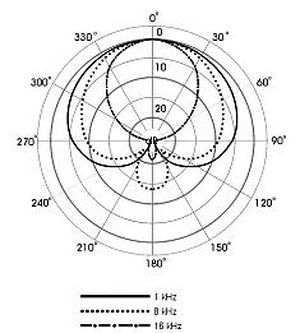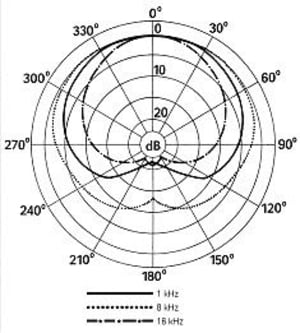3. The Pros and Cons
Many people go by the rule the larger, the better!, but small diaphragm mics are actually superior to large diaphragm mics in many respects. Not all, though.
Low Frequency Response
Theres a common misconception that small diaphragm microphones have inferior bass response than large diaphragm mics. Seems logical, since everybody knows you need a big speaker to transmit low frequencies, dont you? But microphones arent speakers! A microphone does not produce sound, it does not have to put air in motion but is moved by incoming soundwaves. So there is no direct relation between diaphragm size and low frequency response. Even the smallest diaphragms can pick up the lowest frequencies!
Consistent Pick-Up Pattern
The most important advantage of small diaphragms over large diaphragms is that their pick-up patterns are more consistent. On a large diaphragm mic, by contrast, the pick-up pattern is very much frequency-dependent. At high frequencies a large diaphragm produces a very narrow pattern whereas at low frequencies, the pattern becomes very wide. In other words, a large diaphragm mic whose pick-up pattern is specified as cardioid actually tends to be omnidirectional at low frequencies and a hypercardioid at high frequencies. A small diaphragm microphone varies a lot less. A small diaphragm cardioid mic will have a cardioid pattern at all frequencies: The smaller the diaphragm, the more consistent is the mics pick-up pattern. Thats very important especially for distant miking and recording large sound sources such as an orchestra, a choir, or a brass section. A large diaphragm mic would produce an uneven sound image with only the instruments directly on axis sounding bright and full and the sources placed off-axis appearing dull and flat. A small diaphragm mic produces a much more consistent sound image with the off-axis sources (almost) as bright and full as the instruments and voices directly on-axis.


Excellent Transient Response
Small diaphragms provide better impulse response. The diaphragm mass is smaller and therefore less prone to mass inertia. Inertia? Well, it takes a short time for the diaphragm to be set in motion by an incoming impulse and it takes some time for the diaphragm to cease its movement after the impulse has ended. The higher the diaphragms mass, the longer it takes for it to react to an impulse. A small, low-mass diaphragm, therefore, follows the soundwaves more accurately than a large, relatively high-mass diaphragm. Small diaphragm microphones are excellent choices for transient rich material such as acoustic guitar or percussion. (Transients are short, energy rich impulses, typically produced by fast attacks).
Size Matters
Another advantage of the small diaphragm microphone is its compact size. The voluminous microphone body of a typical large diaphragm microphone produces resonances that may compromise its sound. Moreover, although thats mostly a theoretical point, the microphone body is part of the sound field. If you subscribe to the purist philosophy that a microphone is supposed to record a sound source as it is without interfering with the sound field (and thus altering it by reflections), a microphone ought to be as small as possible. A small diaphragm condenser mic is therefore a more ideal microphone than a large diaphragm condenser.
Noise Performance
As you might have guessed, there cant be so many advantages without there being at least one disadvantage. After all, we do use large diaphragm microphones quite extensively in recording studios, dont we? The only point in which a large diaphragm condenser mic is clearly superior to a small diaphragm condenser is noise performance. The larger the diaphragm, the more signal you get. A stronger signal means better signal-to-noise ratio. Small diaphragm microphones, thus, cant be quite as low noise as large diaphragm condensers, and in the early days of audio technology, that was the main reason for using large diaphragm microphones. In the meantime, condenser mics have generally become lower noise, so best possible noise performance is rarely an issue, these days. Still, modern large diaphragm condensers do have considerably lower self-noise than modern small diaphragm microphones. The best large diaphragm condensers boast single digit self-noise figures (the Neumann TLM103 is 7 dB-A!), small diaphragm mics, even the best, rarely are below 15 dB-A. However, keep in mind that the room noise in most recording situations is higher than that, so you may not notice a big difference in many practical applications.
The Pros and Cons in Summary
Small diaphragm condensers have many advantages over large diaphragm microphones. Their pick-up patterns are more consistent, and they are more neutral and accurate. Large diaphragm microphones, on the other hand, are slightly lower noise and tend to have a more distinct sound character, which, at least in some applications, is perceived as complimentary. Large diaphragm condensers often have a flattering quality that makes vocalists sound better and bigger than they really are. Small diaphragm condensers, by contrast, are workhorses that pick up any sound source in its true proportions. Think of large diaphragm microphones as romantics and small diaphragm condensers as realists.
Your Contacts
Product Highlights
Offers
-
Overhead Microphones
-
Small Diaphragm Condenser Microphones
Recommended categories
Do you like what you're seeing?






